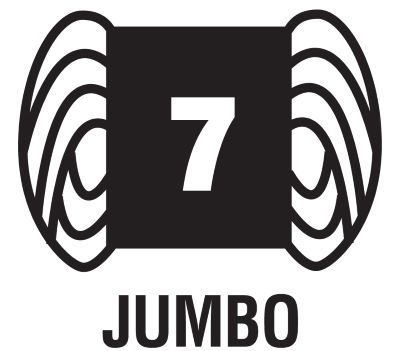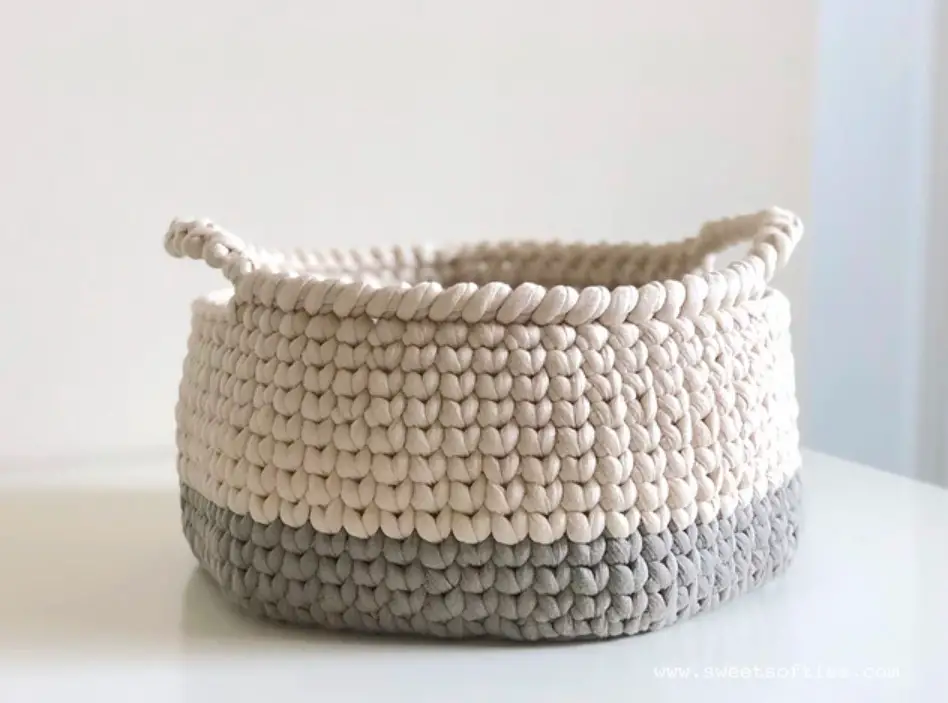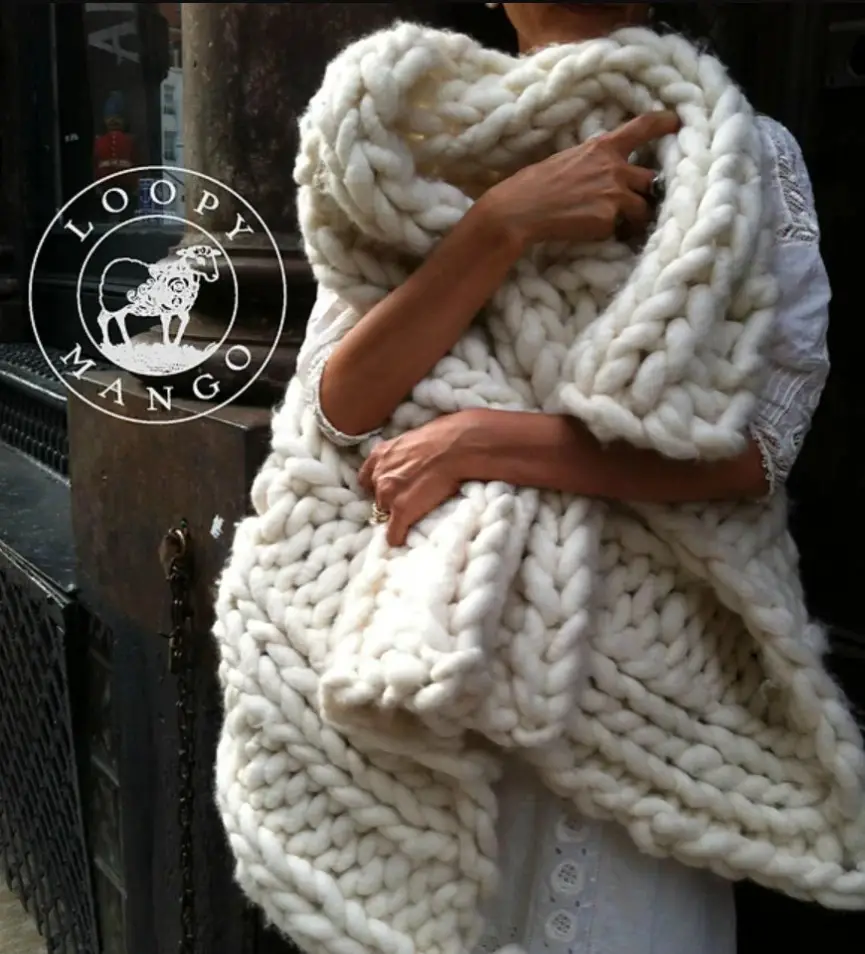Have you ever seen those knit or crochet videos where people use only their hands? They are able to do so because the yarn is jumbo sized.
Jumbo weight yarn is the thickest yarn available. It creates a thick fabric with big stitches. Special tools are designed to knit or crochet the giant yarn, but tools are not necessary to complete projects. Jumbo yarn is great for blankets, accessories and home decor.
I know how difficult it can be to choose yarn when starting out, but yarn weight matters when you want a certain look. Just take a took at the photos above, the large stitches work for those projects, but would not be practical for every project. By the way, these are free patterns listed on Ravelry. Snag them through links here (left to right): Knit Stitch Basket by Sweet Softies and Nantucket Throw by Loopy Mango.
In my previous articles we learned about Lace Weight, Super Fine, Fine Weight, Light/DK Weight, Medium/Worsted Weight, Bulky Weight and Super Bulky yarn. In this one, I want to cover super bulky weight yarn and explain what the industry means by the term. Let’s get to it!
Jumbo Weight Yarn Standards
The Craft Yarn Council (CYC) created a standard yarn weight system for the US. It is based on a number system that starts from 0, the thinnest, and goes up to 7, the thickest. Jumbo weight yarn is what the CYC considers a 7. Besides the numbering system, the CYC also gives guidelines for gauge and hook/needle sizes for super bulky weight yarn.
CYC Gauge and Tool Recommendations
Gauge, hook and needle suggestions for knit and crochet are printed on the labels. These are based on the testing done by the yarn manufacturers.
But the CYC put a set of guidelines for everyone (in the US) to use, which is listed below. The information is based off of the CYC website and you can access that here for more details.
| Standard CYC Gauge* | Recommended Tool Size | |
| Knit | 6 and fewer sts stockinette | 12.75mm and larger, 17 and larger (US) |
| Crochet | 6 and fewer sts sc | 15mm and larger, Q and larger (US) |
Ravelry (an online database for crochet and knitting patterns) also provides a guideline for knit gauge. According to them, you should get 0-6 stitches per 4 inches (10 cm). You can see that this is in align with what the CYC says.
Remember though, these are not exact. The gauge and hook/needle size provide you with a strong baseline, but you should always do your own testing. Being off by a tiny bit can make a HUGE difference with Jumbo weight yarn.
Wraps Per Inch
Wraps per inch (WPI) is useful for yarn weights if you ever lose your labels. Measuring WPI is super simple. The CYC has more detailed information on their website here. But basically you wrap yarn around a pencil. Then you measure an inch and count how many wraps are in that inch. Finally, you compare to the CYC standards for WPI to know what the yarn weight is.
The CYC states that jumbo weight (7) should have 1-4 wraps per inch. Unfortunately, at this time I don’t have any jumbo weight yarn on hand to compare my numbers to, so I checked Ravelry. They say the same thing on their yarn weight standards page, 0-4 WPI for jumbo weight yarn.
Other Common Terms for Jumbo Weight Yarn
As I mentioned previously, the CYC created the yarn weight system for the US. Jumbo weight is equivalent to a 7 according to their standards. But not everyone in the world uses the same terminology. I summarized the most common terms used for jumbo weight yarn below, and I will go into more detail about each.
Also Known As
- Jumbo – 7
- Roving

In the US, and other countries, jumbo weight yarn is typically the term used to refer to the biggest, chunkiest yarn out there, but some may call it roving too. Let’s look at what these mean.
- Jumbo – 7. The Craft Yarn Council added this new yarn weight to their standards in 2014 because of the rising popularity of giant yarns. This is the term most often used to refer to the thickest yarn weight, 7.
- Roving. The CYC lists roving as another term for jumbo. This term means that the yarn is not twisted together into plies. It is a long tube of fibers bundled together, but not spun into yarn. It will give a nice, fuzzy texture.
Important Properties of Jumbo Weight Yarn
Jumbo weight yarn has several important properties that affect every purchaser of yarn. First there is fiber content. It is important to know what fibers the yarn is made from so you know how to treat it for your projects. Next, the yardage is important because that affects the project size. Finally, the price of the yarn is an important property that affects whether or nor you buy it.
Throughout these next sections, I dive deeper into each property of jumbo weight yarn. In order to do so, I conducted my own research. I looked at five major yarn companies so I could understand more about industry behaviors regarding yarn weights. I hope you find it interesting!
Common Fiber Content
I like to break fiber content into three categories: natural fibers, synthetic fibers, and blends of natural and synthetic fibers. According to my research, 4.5% of jumbo weight yarn is made from natural fibers and 66% is made from synthetic fibers. The other 29.5% is a blend of natural and synthetic fibers.
This makes sense because a good majority of jumbo weight yarn is used for home decor items or accessories. The fibers need to last long and have the capability to be washed. Synthetic fibers are better for those reasons, thus more companies use them.
I have summarized the common fibers below. I didn’t add the blends though because that can vary.
Natural Fibers
- Wool
- Merino
- Cotton
- Silk
Synthetic Fibers
- Acrylic
- Polyester
- Nylon
- Polyamide
Yardage Estimation
When it comes to yardage, unfortunately there is no set standard for the amount of yards per ounce/gram. That is up to the yarn manufacturer. But I was curious, just as I am sure you are, how many yards I can expect on average for jumbo weight yarn. This is super important when planning for a pattern.
As I stated before, I looked at 5 major yarn companies in the US. The following is based on my findings. For jumbo weight yarn, you can expect 42 yards per skein on average. The lowest amount of yardage I came across was 7 yards and the highest was 131 yards.
Averge Price
Price is also an important aspect to keep in mind when you are choosing and comparing yarn. I found that you can expect to pay on average $16.40 per skein of jumbo weight yarn. Of course, that also means you could pay much more or much less depending on where you shop.
Where to Find Jumbo Weight Yarn
Jumbo weight yarn can be found in many places. Most chain craft stores do not carry a variety of jumbo weight yarn in stores. Bernat has a few blanket yarns that are considered jumbo. There are also a couple of faux fur yarns that are jumbo sized, but those are not always available in store.
If you have a locally owned yarn shop in your area, you might have a better selection of jumbo weight yarn to choose from. I, however, don’t have that luxury, so I couldn’t tell you for sure.
Finally, you can always buy jumbo weight yarn online. There are many yarn retailers that have jumbo yarns for sale. It is also very popular to find jumbo weight yarn that comes in a kit to make your own blanket.
Types of Projects Best for Jumbo Weight Yarn
Jumbo weight yarn will produce a fabric made up of large stitches and has a chunky look. It is thick (and warm) with little to no drape and can be on the heavy side, depending on what kind of yarn you use.
Compared to the other 7 yarn weights, jumbo yarn is the quickest to work up. I wouldn’t recommend this for every project, but it definitely has its place in the knitting and crochet space. I think it’s a great yarn for beginners because they can really learn about how stitches are made and have a finished project in a relatively short period of time.
Ravelry has a total of 1,343 patterns (at the time of this post) that uses jumbo weight yarn. And maybe half of those are free! You will no doubt find a project that you like.
Popular items to knit or crochet with jumbo weight yarn include hats and home decor items. I compiled a more detailed list of all the project types that I could think of that pair well with jumbo weight yarn. You are by no means limited to only these projects, but I hope these spark inspiration!
Home Decor
- Blankets
- Baskets
- Wall Hangings
- Pillows
- Tree Skirt
- Rugs
- Floor Pouf
Accessories
- Chunky Cowls
- Chunky Scarves
- Chunky Hats
- Bags
Garments
- Chunky Sweaters
- Ponchos
Jumbo Weight Yarn Recommendations + Tips
Jumbo weight yarn has become more popular in the past few years. I personally have not used it much for my projects, but I have coveted my fair share of blankets made of jumbo yarn. One jumbo yarn that I have been eyeing for a project is Lion Brand Go For Faux. It is super soft and would be perfect for many different things. I’m thinking maybe a vest?
Tips:
- Don’t use straight needles to knit jumbo weight yarn. Jumbo weight yarn naturally weighs more than any other yarn weights. It can get uncomfortable fast if you use straight needles to knit a project with jumbo weight yarn. Definitely go for circular needles because the cable will help relieve your hands and arms from the weight.
- Split the ends before you weave them in. Jumbo weight yarn is very thick and the ends can come out much easier than other yarn weights. It is a good idea to split the ends before you weave them in. The pieces will be more secure since the split ends will stick to itself better.
The pictures listed at the top of the post are available in pattern form free through Ravelry. I do not claim these photos as my own, they are merely for illustration purposes. Click the links here to learn more about the designers and patterns: Nantucket Throw by Loopy Mango and Knit Stitch Basket by Sweet Softies.


